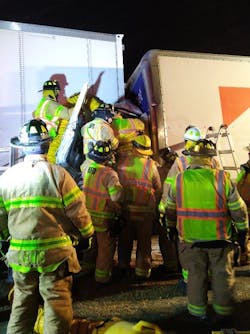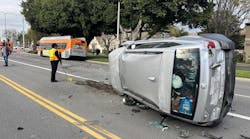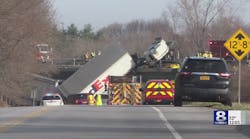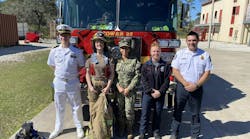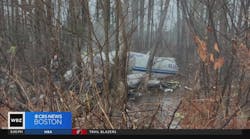On Jan. 21, 2019, at 5:28 a.m., members of the Henrietta, NY, Fire District, along with CHS EMS and the New York State Police (NYSP), were dispatched to Mile Marker 365 of Interstate 90 (a limited access highway) for a motor vehicle accident with entrapment. This was the beginning of one of the most challenging extrications these responders have faced in several years—and under oppressive weather conditions.
Complex extrication
On arrival, companies found a Budget Rental box truck had rear-ended a tractor-trailer in the right lane. The driver of the box truck was conscious and talking, but critically injured and heavily entrapped. The box truck had hit the left rear corner of the trailer, driving the motor out and under the truck and compressing the cab almost flush with the back of the trailer and around the patient.
At this point, the temperature was -5 degrees F with a -30-degree F wind chill. In the previous 24 hours, the area had received approximately 20 inches of snow, creating treacherous driving conditions.
Crews attempted to establish unified command among the major incident stakeholders (fire, NYSP, EMS, Department of Transportation) but, ultimately, fire retained command with the others operating in branches. Overall, this had little impact on the management of the incident. Staging was established at the tollbooth, located about 3 miles away, with two engines that were automatically replenished as resources were called into the scene to relieve crews in the bitter cold.
The occupants of the tractor-trailer were quickly evaluated by EMS, treated and transported, allowing for efforts to be concentrated on the driver of the box truck.
After popping the door to access the driver, plans A, B and C were formulated. Plan A was to peel the cab out from around the patient. The force of the crash caused the cab to almost completely envelop the patient. Due to the damage, crews only had access to the left side of the patient for the majority of the incident.
Crews used hydraulic tools and reciprocating saws to cut away parts of the steering column, dash, seat and cab. All this needed to be completed while working off ladders due to the elevated height of the cab. There were concerns of both crush syndrome and the patient being impaled, as they could not see or palpate the right side of the patient, who was in severe pain.
While plan A was underway, additional plans were being formulated to see if access could be gained through the back of the box truck, or through the trailer. In the case of accessing through the back of the box truck, crews were quick to find that the box had been approximately two-thirds full of packages, and it would take extensive time to unload and make room. Simultaneously, crews set up dual TU32 grip hoists off the back of the box truck to an anchor with the intention of separating the trucks to facilitate room for extrication.
Due to weather conditions, a major concern, in addition to the trauma, was hypothermia, as there was little to no access to put blankets around the patient.
Very early into the incident, command requested a heavy wrecker to the scene to assist with extrication as well as the regional medical director. In our area, the medical director is equipped with a response vehicle (Chevy Tahoe) that is equipped with a full set of paramedic gear and additional advanced equipment not carried by paramedics, and responds to complex incidents throughout the county. This request proved invaluable in patient care.
As part of the rescue cache, the rescue carries a confined-space blower with a heat exchanger (SuperVac Heatpac 25), which was set up so a firefighter was able to blow hot air onto the patient for warmth.
Extrication was ultimately completed by using a chain pull on the dash and steering column and cutting enough material for personnel to manipulate out onto a backboard. The heavy wrecker operator later informed crews that it took two heavy wreckers and two 50-ton winches to separate the trucks.
From the first 9-1-1 call to extrication was 80 minutes, and the patient was on the way to the trauma center within 3 minutes of extrication via ground ambulance.
Upon arrival at the trauma center, the patient’s core body temperature was normal.
Lessons learned
Think outside the box! This was not a normal entrapment call, and we needed almost everything we carried on our apparatus. Be familiar with what you carry and how it works, even though you may only use it once every few years. Also, get to know your outside resources before you need them.
Don’t be complacent: We cover 20 miles in each direction of Interstate 90 and respond there an average of once a week. We have had multiple close calls and, as a result, everything is run by the book. One week later, another major crash took place in the snow approximately 10 miles to the west of this one, which involved 19 vehicles, including several tractor-trailers. One NYSP trooper was seriously injured.
Call for help early: Due to road and weather conditions, there were delayed response times from every facet of the operation.
Safety: First-in crews interviewed the drivers of both vehicles and reviewed the shipping papers, which quickly determined that neither truck was carrying hazardous materials. Additional EMS resources were requested for our own people. Crews were getting cold and tired, but pushed through. Make sure you have people to relieve them. Don’t forget about the other responders as well—EMS, law enforcement and Department of Transportation/tow. Make sure they are included in your rehab plan.
Outcome
The patient was discharged from the hospital a week later with some orthopedic injuries but is expected to make a full recovery.
